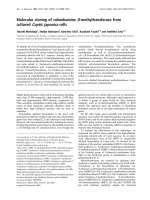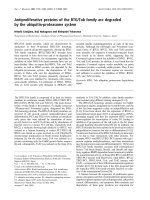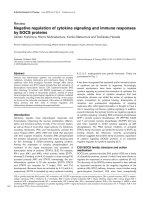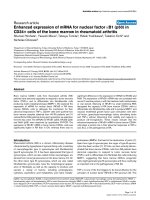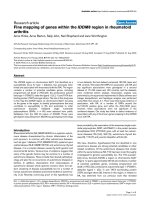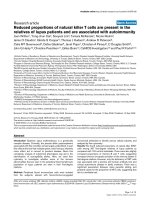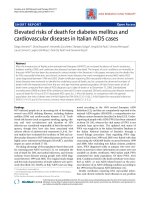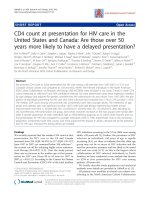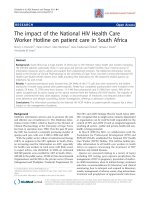Báo cáo y học: "Two standards of care for HIV: Why are Africans being short-changed?" pot
Bạn đang xem bản rút gọn của tài liệu. Xem và tải ngay bản đầy đủ của tài liệu tại đây (185.96 KB, 3 trang )
BioMed Central
Page 1 of 3
(page number not for citation purposes)
Retrovirology
Open Access
Editorial
Two standards of care for HIV: Why are Africans being
short-changed?
Mark A Wainberg
Address: McGill University AIDS Centre, Jewish General Hospital, Montreal, Quebec, Canada H3T 1E2
Email: Mark A Wainberg -
On World AIDS Day 2009, it is appropriate that we reflect
on the accomplishments in HIV therapy that have been
made over the past decade. First, we should recognize that
the impact of the XIIIth International Conference on AIDS
in Durban, South Africa, in 2000 was much more than sci-
entific. It also highlighted the non-acceptability of contin-
uing to deny access to life-saving antiretroviral drugs to
HIV-infected people in developing countries. This was in
spite of efforts by then President Thabo Mbeki of South
Africa to undermine the conference through his ridiculous
and irresponsible insinuations that HIV might not be the
cause of AIDS. Since 2000, it is estimated that the num-
bers of people in Africa receiving antiretroviral therapy
has increased to approximately four million from about
7000 at the time of the Durban Conference. However, the
fact is that almost all HIV-infected persons in developing
country settings are today receiving therapies that are con-
sidered to be sub-standard by Western criteria.
For example, the triple drug combination that is the most
widely prescribed in the world, is termed Triomune. The
reason it is so widely used is that it is cheap as well as
generically produced, and is therefore extensively used in
developing countries where the burden of HIV disease is
so extensive. Triomune is a single pill that is taken twice
daily. It includes three individual drugs that are termed
stavudine (d4T), lamivudine (3TC), and nevirapine
(NVP). Of these, it is only 3TC that continues to be widely
used by patients in Western countries. Indeed, we have
known for at least 7 years that the stavudine component
of the Triomune regimen is associated with severe toxici-
ties that can cause facial and body disfiguration [1]. As a
result, many patients may ultimately choose to be non-
adherent to their antiviral regimens, in part because of the
stigmatizing consequences of these deformities. An obvi-
ous consequence of this may be unchecked viral replica-
tion and the progression of disease.
The problem gets worse. There is now substantial evi-
dence to indicate that patients infected by the subtype C
variants of HIV-1 that are predominant in sub-Saharan
Africa may be especially prone to develop certain drug
resistance-associated mutations in the event that they fail
their antiretroviral therapy [2,3]. One of these mutations
is the K65R substitution in reverse transcriptase. Unfortu-
nately, this mutation has been shown to be associated
with a broad degree of cross-resistance against many
members of the nucleoside reverse transcriptase inhibitor
(NRTI) family of drugs. As a result, many patients who fail
their Triomune regimen will develop the K65R substitu-
tion and may be compromised in regard to opportunity to
benefit from many second-line therapies that might oth-
erwise check viral replication and HIV disease progression
[4]. This is the reason some of the wealthier countries in
Africa such as Botswana and Zambia have now switched
away from the use of stavudine-based regimens in first-
line therapy to instead use other much better tolerated,
more efficient drugs such as tenofovir (TDF), that will
potentially avoid this problem of cross-resistance.
Fortunately, the World Health Organization has recently
recommended that TDF be substituted, wherever possible,
for stavudine in the context of initial therapeutic regimens
in developing countries. However, it may take years for
poorer countries to be able to access alternate medicines
such as TDF, which costs at least twice as much as stavu-
Published: 1 December 2009
Retrovirology 2009, 6:109 doi:10.1186/1742-4690-6-109
Received: 24 November 2009
Accepted: 1 December 2009
This article is available from: />© 2009 Wainberg; licensee BioMed Central Ltd.
This is an Open Access article distributed under the terms of the Creative Commons Attribution License ( />),
which permits unrestricted use, distribution, and reproduction in any medium, provided the original work is properly cited.
Retrovirology 2009, 6:109 />Page 2 of 3
(page number not for citation purposes)
dine, even if it is generically produced. In all likelihood as
well, generic manufacturers of Triomune, that have stock-
piled huge amounts of this antiquated triple cocktail for-
mulation, will be unhappy if their amassed drug supplies
do not make their way to market.
Another major issue in regard to the clinical management
of HIV-infected individuals in developing countries
involves the performance of PCR-based tests to monitor
levels of viral RNA in plasma. It has long been argued by
some that this test is expensive and that the money
involved in performing clinical monitoring of plasma
viremia might be better spent on providing access to
drugs. However, it is important to understand that the
monitoring of plasma viremia represents an essential
component of HIV clinical management in all Western
countries and provides key information in regard to
whether a drug regimen is working or not. Indeed, it is
considered to be unacceptable if a patient's viral load in
plasma cannot be brought down to and maintained
below levels of dectability of the test, i.e. < 50 copies of
viral RNA per ml of plasma.
The reason that it is essential to offer plasma viremia test-
ing is simple. Once HIV plasma viremia begins to rise, this
is usually a sure indication that the therapeutic regimen
being used has probably failed, most likely for reasons of
HIV drug resistance as a consequence of drug-selected
mutations within the target genes of HIV therapy i.e.
reverse transcriptase, protease, and integrase.
It is not only that these mutations can render antiretrovi-
ral drugs less useful than they might otherwise be but, in
addition, because such mutations can sequentially accu-
mulate if a patient continues to be treated with a drug that
is being employed during treatment failure. This, in turn,
can lead to higher levels of drug resistance that might oth-
erwise occur as well as to the potential for sexual transmis-
sion of resistance-associated mutations.
In certain instances, a more serious consequence may be
that the accumulation of drug resistance mutations may
prevent newer compounds that represent a next genera-
tion of drug development from being effective. For exam-
ple, the non-nucleoside reverse transcriptase inhibitor
(NNRTI) etravirine (ETV) is an excellent compound that
maintains efficacy against viruses that contain the most
common mutations associated with resistance against two
first-generation NNRTIs, NVP and efavarenz (EFV). How-
ever, if patients remain on either of these drugs once the
most common of these mutations, i.e. K103N, has
appeared, they will be likely to develop a wide array of
other NNRTI-associated mutations, that will compromise
the use of ETV [5].
The problem with monitoring patients by means other
than plasma viremia, such as CD4 counts, is that the latter
are not well-suited to provide an accurate assessment of
the state of viral replication within infected individuals.
Although CD4 monitoring is essential and provides vital
information in regard to the status of the immune system,
it is well known that drops in levels of CD4 counts usually
take place long after plasma viremia has started to
increase. As a consequence, patients who remain on non-
effective triple drug regimens will continue to accumulate
drug resistance-associated mutations during periods of
relative CD4 stability, since it is only the long-term conse-
quences of unchecked viral replication that lead to CD4
declines. While there is now a trend toward encouraging
the use of viral load diagnostics in all developing country
settings, this recommendation may have come too late for
millions of individuals who have already accumulated
multiple drug resistance mutations in their HIV genomes,
thereby compromising future therapies.
An additional major difference between therapeutic
standards in Western vs developing countries involves the
question of when to start therapy. There is now consensus
in Western countries that patients ought to begin therapy
when their CD4 counts are still above 350 cells/ml
3
[6].
Allowing CD4 levels to decline below this level prior to
initiation of therapy is associated with considerable risk in
regard to both short and long-term responsiveness to
highly active antiretroviral therapy (HAART). This is
doubtless because of the irreparable damage that is
inflicted by HIV replication on the immune system and a
relative inability to recover full immune function despite
the use of antiretroviral drugs. Unfortunately, most peo-
ple, even in Western countries, are still unlikely to begin
therapy with CD4 counts above 350, the reason being that
most individuals are only diagnosed once their CD4
counts have slipped to levels below 250 cells/mm
3
, often
because they may then decide to seek medical advice after
first developing AIDS-related symptoms.
Efforts are now being made in all Western settings to try to
identify HIV-infected individuals far earlier than was pre-
viously the case for several reasons. Among these are the
potential public health benefits of beginning antiretrovi-
ral therapy earlier, such that viral load will quickly dimin-
ish and infected individuals will be less likely to transmit
virus to others [7]. A second obvious benefit will involve
the long term health of infected individuals themselves, if
they are able to begin therapy earlier.
In contrast, most individuals in developing countries
remain unlikely to be diagnosed with CD4 counts that are
above 200. It will take monumental efforts to bring more
widespread and efficacious testing for HIV to developing
country settings in order that patients may benefit from
Publish with BioMed Central and every
scientist can read your work free of charge
"BioMed Central will be the most significant development for
disseminating the results of biomedical research in our lifetime."
Sir Paul Nurse, Cancer Research UK
Your research papers will be:
available free of charge to the entire biomedical community
peer reviewed and published immediately upon acceptance
cited in PubMed and archived on PubMed Central
yours — you keep the copyright
Submit your manuscript here:
/>BioMedcentral
Retrovirology 2009, 6:109 />Page 3 of 3
(page number not for citation purposes)
HAART to the same extent as has occured in the West. This
problem is also complicated by the fact that stigmatiza-
tion of HIV disease is far worse in many developing coun-
tries than is the case, for example, in Western Europe and
North America [8].
As if the above were not enough, there is even concern
that the generic drugs being made available in some devel-
oping countries may not be of the same quality as those
that are produced by major pharmaceutical companies
[9]. It is vital that high standards of bioequivalence be
maintained in all countries in which generic HIV drugs are
employed, since the use of drugs with fewer active compo-
nents will increase both the rate of emergence of drug-
resistant HIV variants and their transmission. Some
observers have even raised the possibility that fake drugs
might have found their way to the market in some devel-
oping countries.
In short, considerable progress has been made in develop-
ing settings, including most African countries, in regard to
HIV drug access. However, enormous chasms in regard to
standards of care, diagnostic services, and qualities of
drugs employed continue to distinguish developing from
developed countries, as has been previously pointed out
[10]. It is simply not true that HIV disease has been trans-
formed for most people into a chronic manageable condi-
tion in a developing country context, in the way that we
hold this to be true in the West. Although international
bodies such as the World Health Organization are trying
to resolve some of these issues, as will be reflected in new
sets of guidelines to be published shortly, implementa-
tion of change will not be easy or fast. We must all work
harder to ensure that these gaps shrink as quickly as pos-
sible if we are to realize the ideals and dreams of the XIIIth
International Conference on AIDS that was held in Dur-
ban only nine years ago.
Mark A. Wainberg is Professor of Medicine and of Micro-
biology at McGill University in Montreal where he is the
Director of the McGill AIDS Centre at the Jewish General
Hospital. He was the President of the International AIDS
Society between 1998-2000 with responsibility for organ-
ization of the XIIIth International Conference on AIDS
that was held in Durban, South Africa during July 2000.
References
1. Joly V, Flandre P, Meiffredy V, Leturque N, Harel M, Aboulker JP, Yeni
P: Increased risk of lipoatrophy under stavudine in HIV-1-
infected patients: results of a substudy from a comparative
trial. AIDS 2002, 16(18):2447-54.
2. Doualla-Bell F, Avalos A, Brenner B, Gaolathe T, Mine M, Gaseitsiwe
S, Oliveira M, Moisi D, Ndwapi N, Moffat H, Essex M, Wainberg MA:
High Prevalence of the K65R Mutation in Human Immuno-
deficiency Virus Type 1 Subtype C-Infected Batswana
Patients Treated with ddI-based regimens. Antimicrob Agents
Chemother 2006, 50(12):4182-5.
3. Hosseinipour MC, van Oosterhout JJ, Weigel R, Phiri S, Kamwendo
D, Parkin N, Fiscus SA, Nelson JA, Eron JJ, Kumwenda J: The public
health approach to identify antiretroviral therapy failure:
high-level nucleoside reverse transcriptase inhibitor resist-
ance among Malawians failing first-line antiretroviral ther-
apy. AIDS 2009, 23(9):1127-34.
4. Invernizzi CF, Coutsinos D, Oliveira M, Moisi D, Brenner BG, Wain-
berg MA: Signature nucleotide polymorphisms at positions 64
and 65 in reverse transcriptase favor the selection of the
K65R resistance mutation in HIV-1 subtype C. J Infect Dis 2009,
200(8):1202-6.
5. Vingerhoets J, Peeters M, Azijn H, Tambuyzer L, Hoogstoel A, Nijs N,
de Bethune MP, Picchio G: An update of the list of NNRTI muta-
tions associated with decreased virological response to etra-
virine (ETR): multivariate analysis on the pooled DUET-1
and DUET-2 clinical trial data. Antivir Ther 2008, 13(Suppl
3):A26.
6. Kitahata MM, Gange SJ, Abraham AG, Merriman B, Saag MS, Justice
AC, Hogg RS, Deeks SG, Eron JJ, Brooks JT, Rourke SB, Gill MJ, Bosch
RJ, Martin JN, Klein MB, Jacobson LP, Rodriguez B, Sterling TR, Kirk
GD, Napravnik S, Rachlis AR, Calzavara LM, Horberg MA, Silverberg
MJ, Gebo KA, Goedert JJ, Benson CA, Collier AC, Van Rompaey SE,
Crane HM, McKaig RG, Lau B, Freeman AM, Moore RD, NA-
ACCORD Investigators: Effect of early versus deferred antiret-
roviral therapy for HIV on survival. N Engl J Med 2009,
360(18):1815-26.
7. Quinn TC, Wawer MJ, Sewankambo N, Serwadda D, Li C, Wabwire-
Mangen F, Meehan MO, Lutalo T, Gray RH: Viral load and hetero-
sexual transmission of human immunodeficiency virus type
1. Rakai Project Study Group. N Engl J Med 2000,
342(13):921-9.
8. Wainberg MA: HIV transmission should be decriminalized:
HIV prevention programs depend on it.
Retrovirology 2008,
5:108.
9. Byakika-Tusiime J, Chinn LW, Oyugi JH, Obua C, Bangsberg DR,
Kroetz DL: Steady state bioequivalence of generic and inno-
vator formulations of stavudine, lamivudine, and nevirapine
in HIV-infected Ugandan adults. PLoS One 2008, 3(12):e3981.
10. Jeang KT: World AIDS Day 2007: AIDS at 26, are we there
yet? Retrovirology 2007, 4:86.
